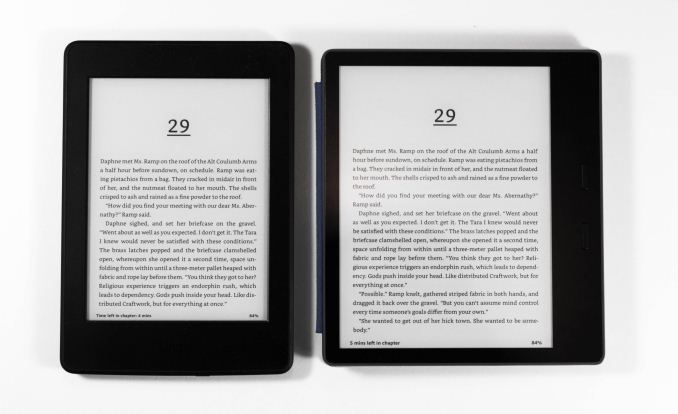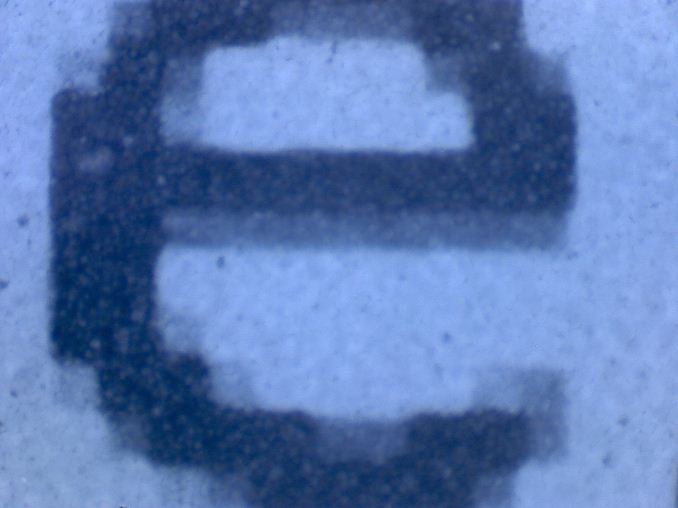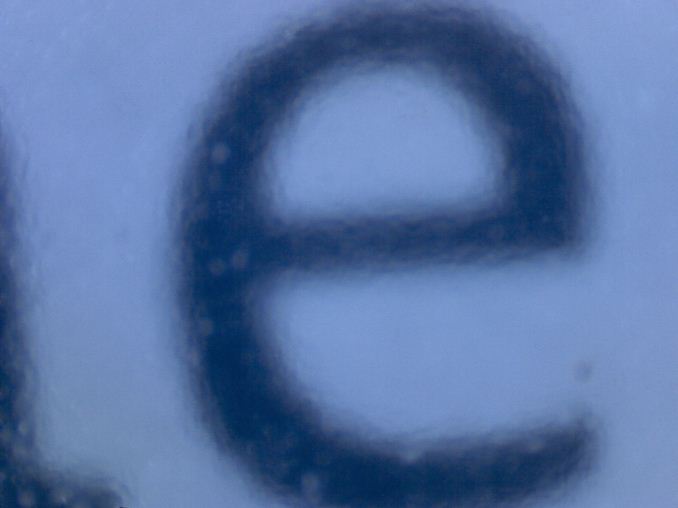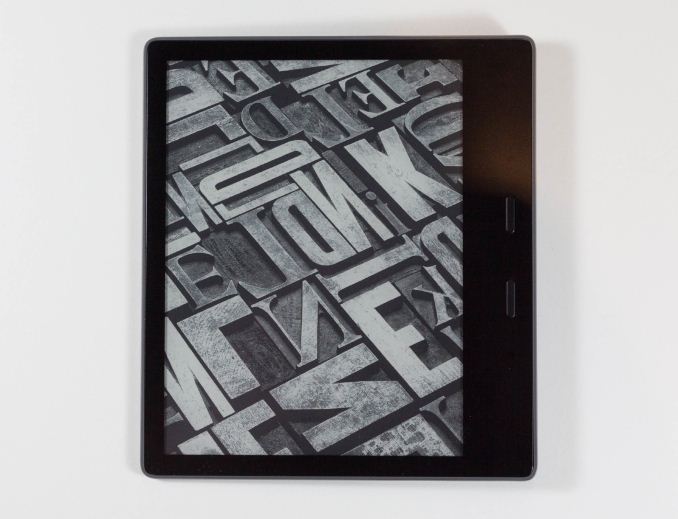The Amazon Kindle Oasis (2017) Review: A Premium Take On The E-Reader
by Brett Howse on January 25, 2018 8:00 AM EST- Posted in
- Accessories
- Amazon
- Kindle
- e-ink
- E-Reader
- Kindle Oasis
Display and Performance
If you’ve never used an E Ink display for reading before, you’re likely wondering what all the fuss is over. You can read books on your phone right? Yes, of course, but the benefits of this display technology make it well suited to a dedicated E-Reader.
First, the displays are not backlit like an LCD, but instead they rely on reflected light, just like a book. The electronic ink itself also requires no power to hold a static image, which helps with long battery life without a heavy device. Finally, unlike LCDs, E Ink doesn’t wash out in bright sunlight. All of these make it a fairly ideal display technology for E-Readers. If you do read a lot, and you’ve only read on a phone, it’s likely worth the time to give an E Ink device a try.
Amazon has continually improved their E-Readers, and the Oasis is the best device I’ve used yet as far as the display is concerned.
The first thing to look at is the display resolution, which Amazon just quotes in pixels per inch. All of the current Kindles, with the exception of the base model, utilize a 300 PPI display. The base Kindle has a 167 PPI display. We all know how higher pixels per inch help make text clearer on smartphones and PCs, and on a Kindle, it’s exactly the same. At 300 pixels per inch, there’s really not much need to ever go higher. The text is perfectly clean and crisp. Here’s a comparison image from a Kindle from 2012 compared to the latest Kindle Oasis.
150 PPI Kindle display (2012 model) vs 300 PPI Kindle Oasis
The level of detail is pretty much perfect on the current generation, and the letter e looks about the same as it would in a printed book. Amazon also has created some custom fonts for Kindle to work best with their display technology, and they really do look great. But this isn’t necessarily a reason to get the Oasis over a Paperwhite, since both have the same pixels per inch. It’s definitely a reason to not get the base Kindle though, since it’s just 167 PPI.
Lighting is an area of differentiation though. The base Kindle has no lighting at all, but the Paperwhite and Voyage do. The Paperwhite has 4 LEDs to light up the display, and the Voyage has 6. The Oasis cranks that up 12 LEDs, which gives a much more uniform look to the display when using the lighting. It also adds more features you’d expect on a modern device such as automatic brightness, and smart features like being able to dim the display over time when reading in the dark, since your eyes won’t need as much light over time. The LEDs on the Oasis are also warmer compared to the Paperwhite, which has a cool tone to it. It’s still on the cool side, but closer to a neutral white.
Obviously, the larger display is also a differentiator, and Amazon did that without drastically increasing the footprint of the device, thanks to the thinner bezels on the three sides. The larger display lets you read more text per page turn, which would be even more important if you like to use larger fonts when reading.
Speaking of page turns, Amazon has moved to a different processor in the Oasis. The rest of the current Kindle lineup uses a 1 GHz Cortex A9 design in the i.MX6SL. For the Oasis, they’ve moved to a more modern i.MX7D which is a dual-core Cortex A7 processor. Despite the A7 being an in-order CPU, it’s much more optimized than the A9, and having the second core of course helps as well. Both SoCs peak at 1 GHz, but the dual-core model coupled with a newer EPD controller makes the entire device feel a lot more snappy. Page turns are much quicker, and there’s less of the ghosting effect when the E Ink refreshes. The controller also appears to completely get rid of the need to enable the forced complete page refresh on every page turn. For those that don’t use E Ink, Amazon stopped refreshing the entire display on every page turn quite a few generations ago, which lets them turn the page quicker. The downside of that is that occasionally there could be some artifacts of the previous page left as light marks. They’ve always allowed you to force a complete refresh to avoid this, but it does slow down the page turn. Normally it’s not a huge issue, but you can see it from time to time, but with the Oasis, I’ve not seen it once.
Overall the new processor really improves the performance. Page turns are about twice as fast, and without any artifacts left behind. A dual-core Cortex A7 might seem like a pretty weak CPU when you’re comparing it to a smartphone, but it does do well in the Kindle Oasis.
Battery Life
Compared to the laptop reviews that we do, measuring battery life on a device that’s intended to go multiple days or weeks without charging is a bit of a problem. We don’t have battery life scripts or applications to test it out and provide a good number. Instead, I just used it every day for the past couple of months, for about 30 minutes per day. On average, I’ve had to charge it roughly every 2.5 weeks, with the display set at 20 brightness out of 24, auto-brightness disabled, and wireless left on.
If you read a lot, you’ll need to charge it more often, but it’s about nine hours of battery life while the device is in use, over the 2.5 weeks, and is enough to get through most books before needing a charge. Charging is done with a micro USB cable, which is supplied, but Amazon no longer includes an AC adapter in the box, because at this point, most people already have several.














93 Comments
View All Comments
LeftSide - Thursday, January 25, 2018 - link
Thanks for the review! One of the biggest features I use on my kindle is the OpenDyslexia font. It really helps with my read speeds and accuracy. I have an older kindle with less DPI. I’m thinking 300dpi would help even more to smooth out the fonts. I’ve been looking to replace it soon, and this is the best review I’ve seen so far.PeachNCream - Friday, January 26, 2018 - link
The higher DPI and lighting really helps the reading experience a lot. I had the bottom end Kindle from around 2012 for a long time and had to replace it when my ex took it along to move in with the new girlfriend. I ended up getting a Paperwhite as a replacement and it's been a nice upgrade over the old one, though I feel like the old Kindle had better battery life from the start. Even with the backlight and WiFi turned off, the Paperwhite seems to require a recharge more often than I remember the old Kindle needing when it was new.nico_mach - Monday, January 29, 2018 - link
I like my entry level kindle because without the extra tech, it's the lightest kindle and the best battery life. I ditch my case all the time, making it incredibly light. But my wife loves her paperwhite, she reads in bed in the dark all the time and I get that. Every review says it's essential, but books were never backlit, right?For bedtime reading, I wish the paperwhite etc had a redder light.
mode_13h - Monday, January 29, 2018 - link
Kobo Aura ONE has a nighttime reading mode, for the light.DanNeely - Thursday, January 25, 2018 - link
Nice to see an extended review of a niche device like this. I do enough reading on my current kindle, ~100 novels/year that if/when I need to replace it; I probably will spring for this model.The main counter argument against doing so now are that my old Kindle Keyboard (gen3) still works and still has a reasonable battery life ~2.5-3 down from ~4.5 when new. My reading pattern's bursty enough (I might read 5 in one week and none for the next two or three weeks) that I normally leave the wifi off to avoid finding it dead if I left it off the charger for too long.
A secondary annoyance is that I don't want to keep carrying multiple sets of chargers/cables when on the road. My phone's USB-C, my next laptop will be USB-C powered, and I really don't want to still be carrying a second cable for my Kindle a half dozen years from now because it's still using a micro-B plug. I know it's less of an issue for people who've got a much larger collection of USB powered devices to pack along because they'll have multiple long tail devices on the old standard for a while and probably will want more cables for parallel charging anyway; but the 3 devices I mentioned are all I normally take with me.
erwos - Thursday, January 25, 2018 - link
I flat-out won't buy new electronics over about twenty bucks unless they have USB-C. Micro-B is on the way out and it was never a very durable connector to begin with. Even USB-A is starting to show signs of obsolescence.I don't know why Amazon seems so resistant to USB-C, but they really need to start migrating their product lines to it. I am flat-out not buying a new Kindle or a Fire until I see USB-C on them.
DanNeely - Thursday, January 25, 2018 - link
My suspicion is that it's about cost because almost all Amazon branded electronic products are priced low enough they're at best barely breaking even if not selling them at a small loss to support their stores to the extent that even adding a dollar to the BOM cost is a big deal. I pricechecked on mouser.com (a electronic component supply company), and in bulk quantities (tens of thousands) you can get micro-b connectors for as little as $0.15, vs $0.95 for USB-C sockets. When the Oasis first came out the price premium was higher, IIRC over a dollar.While the Oasis is an exception to Amazon's race to the bottom/loss leader pricing strategy I suspect they hesitate because adding it to one model would increase consumer pressure to add it to the more mass market parts.
I expect the price gap for the newer connectors to continue to narrow as supply increases and the manufacturing companies gradually pay off their capital expenses for the new manufacturing hardware. I'm skeptical that they'll ever get as low as micro-b connectors. This both because the USB-C port is more complex and because phones going USB-C has resulted in a large production excess for micro-B ports. Short of something else replacing USB-C connectors (wireless charging, and wifi/bt only, or a notional USB-D connector some years down the line) we're unlikely to see a massive excess in production capacity pushing down prices through the basement floor.
grant3 - Thursday, January 25, 2018 - link
1. You can find USB-C sockets all over alibaba for under $0.35/ea and some as low as $0.08/ea2. Oasis is the premium Kindle, for $250, even if USB-C costs an extra few cents, this is the appliance that deserves it.
kcladyz - Friday, August 2, 2019 - link
That is stupid to not buy something over a charging port. Amazon charges super fast and it fits many of my other devices such as my NOOK.shonferg - Thursday, January 25, 2018 - link
I have this as well and have really liked it. The one thing that disappointed me about it, though, was that the blacks on my older Paperwhite from 3 or 4 years ago are noticeably darker. The biggest reason I decided to pay for the new device was that they finally increased the screen size, and I thought this, plus the increased resolution and storage space, would make reading manga much better. It is better on balance and worth the upgrade, but the way the pictures look a bit washed out compared to the old model is a bit disappointing. I haven't seen this mentioned in any reviews yet, which makes me wonder if it's just my device or if they are all like this.